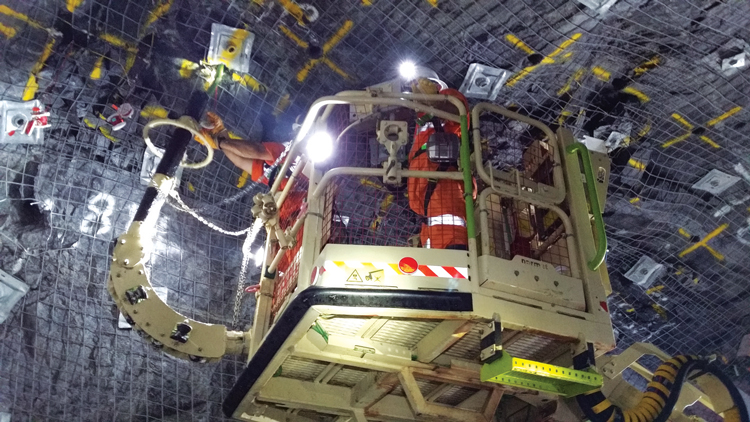
Charging 76-mm up-holes from the FOPS-equipped basket on a Normet Charmec.
The development of bulk explosives brought with it the need for new concepts in handling and charging. E&MJ looks at some of today’s choices.
By Simon Walker, European Editor
Remember when the preparation of bulk ANFO involved taking a bag of fertilizer, adding a measure of diesel fuel and blending thoroughly in a converted concrete mixer on the back of a pick-up truck? No matter that there was a bit of spillage, or that the blend was not quite the same from batch to batch. It did the job. But slowly.
Fast forward to the high-pressure environment of drilling and blasting in a modern open pit, or in an underground development heading, and the room for “give-or-take” in explosives handling and charging is no longer there. With blastholes set out and orientated by GPS to give the optimum breakage in the specific pit conditions, every kilogram of explosive of whatever composition has to do its job. And that means the blend must be spot-on, each hole must be charged exactly to the blast design, and the entire operation completed within the time window allowed by the production or development schedule.
No wonder, then, that explosives handling and charging has become a specialized technology in its own right, driving a market for custom-designed vehicles that give the safety, precision and cost control demanded on modern mines. E&MJ asked a number of the manufacturers involved in supplying these to both the surface and underground sectors for their input.
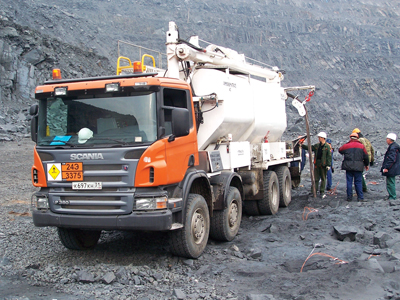 A leading supplier to the Australian market, IEE has also shipped its custom bodies worldwide.
A leading supplier to the Australian market, IEE has also shipped its custom bodies worldwide.AUSTRALIAN EXPERTISE
International Explosives Equipment (IEE) was founded in 1989 to carry out servicing on blast trucks working in the Australian explosives industry. The company’s business manager, Gary Parkinson, told E&MJ that within a few years IEE had established itself as a body builder in its own right. “From humble beginnings in a remote Kalgoorlie workshop, IEE is now at the forefront of the explosives industry in a state-of-the-art 14,500 m2 facility located in Perth, Western Australia. With 7,150 m2 of workshop space, the new purpose-built plant enables IEE to streamline the production, giving an improved turn-around on projects from order placement to the market place,” he said.
IEE can design and build ANFO, heavy ANFO, multiple mix units and underground bodies as well as a wide range of complementary products such as ammonium nitrate (AN) loading augers, AN emulsion storage and pumping systems, calibration equipment and AN emulsion manufacturing modules, amongst others. Serving both the domestic and export markets, IEE has shipped more than 100 units globally, with the majority having been designed for shipping inside a 40-ft, high-cube container.
The company’s multiple mix pump units can manufacture ANFO and heavy ANFO, and deliver a blended product to the blasthole. Bins and tanks are provided for AN and emulsion storage, fuel oil, water and optional additives. The product is discharged using a side-mounted auger, or pumped into wet holes using a loading hose. Emulsion is generally added to the ANFO in the discharge auger.
IEE said its ANFO mix module units represent the simplest method to manufacture ANFO, consisting of an AN storage tank and a process fuel oil tank. These systems are self-contained and manufactured so they can easily be fitted to a standard flat-bed truck. Similarly, its heavy ANFO units are designed to fit on a cab chassis. Specialized controllers provide ingredient percentages and individual ingredient rates, allowing batch and total amounts to be recorded.
US HQ, EQUIPMENT WORLDWIDE
With corporate offices and manufacturing facilities located in Roanoke, Virginia, USA, and service capabilities managed from Chile, Australia and South Africa, Tread Corp. was founded in 1957. Since then, the company has grown and diversified its product range, leading to its main focus today—providing the blasting industry with bulk explosives-handling equipment.
Tread told E&MJ that it holds “U” certification for manufacturing pressure vessels from the ASME, and “R” certification for the repair and alteration of pressure vessels from the U.S.
National Board of Boiler & Pressure Vessel Inspections. The company is also a member of the International Society of Explosives Engineers (ISEE) and the Institute of Makers of Explosives (IME). Its equipment complies with U.S. standards established by the ATF, OSHA, MHSA, NFPA and DOT.
While Tread builds matrix mix plants, storage bins and magazines, its main focus is in the production of bulk trucks, including the Treadbed and Unibody designs. As the explosives industry began converting from package products to bulk ANFO, the company expanded its line of equipment and developed the Treadbed bulk truck. These were designed, engineered and operationally dedicated specifically for use in the explosives industry.
With the subsequent introduction of bulk emulsions and various additives that gave blasters the ability to custom mix at the borehole, Tread expanded its truck offering to complement these new technologies by providing blend, pump, and quad-type trucks.
The Unibody truck design is a product solution that was driven by customers requesting a convertible bulk truck body that could be reconfigured to deliver the right mix of products required for any particular job. The Unibody is versatile, expandable and light-weight compared to other options on the market, Tread claims.
The Unibody’s four-compartment body comprises a prill bin at each end with two center tanks that can be converted to haul prill or emulsion. The capability to convert the tanks and add a hose reel and pump module to the original unit provides the flexibility required to realize maximum utilization and achieve optimum operation, Tread states.
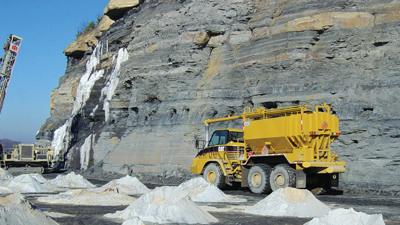 The U.S.-based company read Corp. builds ANFO and emulsion bodies on a range of truck chassis.
The U.S.-based company read Corp. builds ANFO and emulsion bodies on a range of truck chassis.CHARGING IN CHILE
The German manufacturer of LHDs and utility vehicles, Hermann Paus Maschinenfabrik, has worked closely with Chile’s copper giant, Codelco, to develop an ANFO charging vehicle specially designed to meet the company’s requirements at El Teniente. The world’s largest underground copper mine, El Teniente produced over 450,000 metric tons (mt) of fine copper in 2013, plus molybdenum.
The main mining method is panel caving, with ANFO used as the blasting agent in 75-mm (3-in.) production holes up to 25 m long. Some 3,000 kg of ANFO are needed for a typical production blast, according to Paus, with Codelco aiming to optimize the process—and hence be more productive and save costs—by cutting charging times and reducing the need to transport explosives.
The concept behind the new machine is to combine ANFO transport and charging, with the unit having enough charging capacity for a full round. It is based on Paus established Universa 50-2, powered by a Deutz TCD 2012 diesel engine, and with Posi Stop axles and a Dana Spicer hydrodynamic drive line. The Universa 50 is equipped with an ANFO storage platform with a maximum capacity of up to 120, 22-kg bags, a 500-liter ANFO vessel, a rotary vane compressor and a telescopic platform at the back to cover the complete drill pattern from one carrier position.
Paus told E&MJ that Codelco ordered five new machines last year with another scheduled for delivery in 2015. Three have a Triplex boom and three a Paus HLK 30 boom, which gives a working height of more than 7 m (23 ft) and can cover 40-m2 faces. All the machines have additional safety features that conform to Codelco’s FCS3 Fatality Control Standards.
Paus states that Codelco is impressed by the machines’ charging rate of up to 150 kg per minute, while the on-board storage capacity of more than 3,000 kg helps to improve the ANFO-handling logistics underground. Despite the units’ compact dimensions, this and the use of the 500 liter ANFO vessel means that a greater proportion of each cycle is available for charging.
LONG-REACH CAPABILITIES
The U.S. company, Oldenburg, offers a two-model range of underground ANFO trucks, the UV-6 and UV-11. Powered by a 97-kW (130-hp) Tier 3-compliant Cummins QSB 4.5 engine, the UV-6 is equipped with a single-stage, 320-kg (700-lb)-capacity telescopic boom with a 1,066 × 1,372-mm (42×54 in.) basket. Its rectangular single setup face coverage is 6.4 m (21 ft) high by 9.4 m (31 ft) wide, based on a man’s reach of 2.1 m (7 ft). The man-basket includes self-leveling and side-to-side rotation as standard, the company noted.
ANFO-charging features include two 450-kg (1,000-lb)-capacity, stainless steel ASME-certified vessels with automatic material vibrators. The dual delivery system has two remote pneumatic controlled material valves for hole cleaning and ANFO delivery modes, each delivery system including 33 m (110 ft.) of anti-static rubber hose, and 7.6 m (25 ft.) of anti-static plastic feed hose for in-the-hole use. Two compact, lightweight remote air pilot valves can be belt-mounted by the operator during remotely controlled hole-cleaning and ANFO delivery.
Oldenburg claims that the larger UV-11 ANFO truck provides more standard features than any competitive unit to provide the owner/operator with the best value in the mining equipment industry. Its two-stage telescopic boom carries a 612-kg (1,350-lb)-capacity, 1,066 × 2,032-mm (42 × 80-in.) basket with a canopy. The rectangular single setup face coverage is 8.5 m (28 ft) high by 14.6 m (48 ft) wide, with a maximum boom reach of 11.6 m (38 ft).
In tramming mode, the two machines measure 11.9 m and up to 13.7 m long (39 ft 1 in. and 44 ft 9 in.), respectively, (the UV-11 can be equipped with different boom and basket combinations to suit the application), while their inside turning radius of 3.1 m and 3.6 m, respectively, (10 ft 1 in. and 12 ft) means that they are highly maneuverable even in tight tunnel sections.
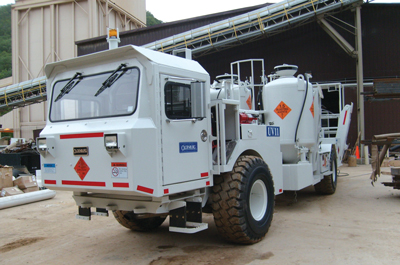 The UV-11 is the larger of Oldenburg’s two underground models.
The UV-11 is the larger of Oldenburg’s two underground models.55 YEARS OF EXPERIENCE
Company Vice President Randy Erb told E&MJ that Amerind, a division of Pemberton Fabricators in Rancocas, New Jersey, USA, has been building bulk trucks for the mining and construction industry since 1960. The company builds simple ANFO trucks, ANFO-emulsion blend trucks, blend/pump trucks and straight pump trucks, Erb said, with capacities from 3 to 25 short tons.
Amerind can install its equipment on any chassis that its customers supply, and has even fabricated a custom-made 40-short ton unit to install on a Belaz haul truck. Its equipment is now working all over the world, from extremely cold climates in Siberia and northern Canada to hot locations like South Africa.
Amerind claims to be the first company to have manufactured bulk ANFO trucks. Since at the time only agricultural AN prill was available, the first units incorporated the use of a hammer mill to crush the material. These mills can still be an option where high-density ANFO is required.
Blend trucks can produce any product from 100% ANFO to 100% emulsion, and as in the ANFO truck controls, the blend truck can be operated manually from outside, with electric controls in the cab, electric controls on a pendent, or by radio remote control. AN capacities can vary from 4 to 15 short tons, with from 500 to 3,000 U.S. gallons of emulsion.
The company’s pump trucks carry emulsion tanks with capacities of 500–4,000 U.S. gallons. Hose reels can be mounted behind the cab or at the rear of the truck, and can be stationary or swivel through 180°.
Erb told E&MJ that Amerind’s newest innovation, Blend Master, uses Danfoss Plus 1 displays and controllers to give an extremely user-friendly and customizable operating system. In use in the field since 2005, Blend Master has a touch-screen operator interface and data logging with extraction to a shot report. The information retrieved covers the operator name, customer name, date, start time, stop time, amount of product in each hole (AN, emulsion, fuel oil and two-part gassing), and end-of-day totals for each product.
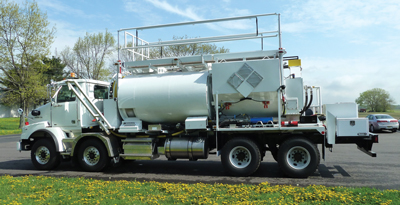 A blasthole-charging unit that Amerind custom-built on the owner’s specified chassis.
A blasthole-charging unit that Amerind custom-built on the owner’s specified chassis.BLOCK-HOLING IN SAFETY
Not all blasting involves safe working conditions, and the Sudbury, Ontario-based company, Marcotte Mining Machinery Services has developed what its general sales manager, Mark Dunseith, described to E&MJ as “a unique machine, unlike anything else.” Designed for use in blasting blockages where an operator might be exposed to danger, the M5 Weasel can navigate into tight spaces that are not accessible by conventional means.
Removing blockages or handling oversize debris is now possible with greater safety and efficiency, Dunseith said. The operator uses remote controls to bring the Weasel into position, then a multi-axis telescopic boom is used to advance an air-powered jackleg drill to the blockage. When the drill depth is achieved, the Weasel is backed away from the area, and the operator interchanges the drill rod with a loading stick and blast wire. Once back in position, the loading stick is inserted using the feed extension to charge the hole, with the blast wire reel automatically paying out when the Weasel is finally reversed away. The shot is then fired conventionally.
The Weasel is driven by two independent air motors and mechanically linked drive assemblies that offer four-wheel drive and highly maneuverable skid-steer turning. Using air motors for the drive system also eliminates any engine emissions, Dunseith pointed out. An air-driven alternator and battery arrangement powers a full light package, giving good visibility for the operator while positioning the machine from a safe distance.
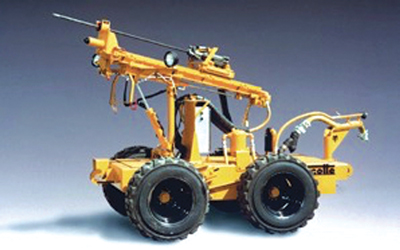 Marcotte’s Weasel is designed for safe blockage blasting.
Marcotte’s Weasel is designed for safe blockage blasting.A FULL TRANSPORT AND CHARGING RANGE
Normet’s Charmec vehicles come with a bulk explosive charging kit for either ANFO or emulsion, and can be used in production and face charging works. Charmec configurations typically include one or two mobile elevating work platforms with a platform reach ranging from 4 to 11 m (13–36 ft). The operator charges the holes from a basket protected by a FOPS canopy.
Mechanized charging-hose handling systems are available as options for emulsion use in face charging, and for emulsion and ANFO in 40-m (130-ft)-long up and down holes. All
Charmec models come with additional boxes for detonators and primers.
Normet produces three different sized articulated base carriers with payload capacities of 6, 10 and 16 mt, respectively, and engine power classes ranging from 90 to 170 kW (120–228 hp). An electro-hydraulic power pack is available for all models, allowing operators to work in clean air at the face as a diesel engine is not needed to run the machine functions during charging.
Normet said its modular and mass customized Charmec SF, MF and MC, and LF and LC models are designed for easy upgrades during a machine’s lifetime. For example, an ANFO vessel kit can easily be removed and replaced with an emulsion pumping system. Electro-hydraulic power packs or hose reels can also be retrofitted.
The fully mechanized Charmec MF for up-hole loading comes with a robotic boom equipped with a hose reel and hose feeding kits, and space for 10 or 16 mt of emulsion or ANFO tanks and pumping systems.
The most advanced Charmec systems include the LC 605 VE fully integrated emulsion charger, which uses Normet’s NorSmart electronic control system to control emulsion charging and the pumping process, along with other machine functions. The hole charge in profile and near profile holes can be regulated either by string loading in face charging or by gassing a lower explosive specific weight in production charging. This gives a smooth profile in the tunnel and stope wall and minimizes the need for rock support and waste rock dilution, the company noted.
Normet’s Himec and Utilift man lifters can be used where charging is done with cartridges, with all dedicated Charmec concepts being available as Himec and Utilift versions as well, without the charging kit.
The company also offers its SF, MF and LF Series Utimec and Multimec explosive transport vehicles. The Utimec is a dedicated explosives transporter that can be supplied as a combined unit for transporting men and explosives. The Multimec comes with a slide-on, slide-off cassette system allowing the same base vehicle to be used for transporting explosives as well as for other utility applications during the shift. The explosives transport compartments on all these vehicles are covered with non-sparking materials, Normet added.
FROM CANADA TO THE WORLD
Today a member of the Astec Industries group, Ontario-based Breaker Technology (BTI) and its predecessor equipment companies have been supplying the mining industry since 1958.
The company has been equipping mines around the world with blasthole-charging solutions since the late 1970s. BTI told E&MJ that its series of ANFO- and emulsion-loading vehicles are heavy-duty, low-profile units specifically designed for short- or long-hole explosives loading, being self-contained with single or dual charging vessels.
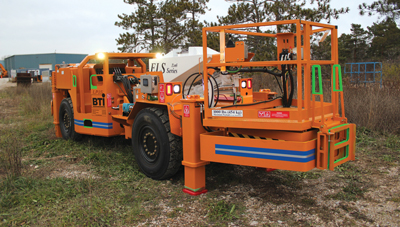 Emulsion loaders from the Canadian company, BTI, can be specified with a range of booms, cabs and delivery systems.
Emulsion loaders from the Canadian company, BTI, can be specified with a range of booms, cabs and delivery systems.With three carrier configurations and multiple engine options, each truck can be equipped with a man-basket boom or a scissor lift to tackle every headings of any size, and are matched with the appropriate size of explosive holding tank(s) and storage containers. Solid stainless steel tanks in single and double tank layouts are available with capacities ranging from 270 to 910 kg (600–2,000 lb).
The three coverage options available encompass 1.4-, 2.8- and 4.3-m (4.5-, 9- and 14-ft) extension booms, or an extendable scissor platform for various face-loading requirements. A two-person man-basket positions the operators so that blasthole charging is done safely and efficiently, while four heavy-duty stabilizers provide positive boom stability. The turret-mounted boom allows up to 270° of rotation for single, double or triple face coverage.
The company noted that other options such ROPS/FOPS cabins, fire-suppression systems, multiple discharge hoses, air compressors, electric-hydraulic power packs and auto-lubrication systems allow it to tailor vehicles to customers’ specific requirements.
As examples of its success worldwide, BTI’s ELS series emulsion loaders can be found in lead and zinc mines in China and in gold mines in Mali. Its ALB series ANFO loaders are currently working in gold mines in Canada, along with lead, zinc and copper mines in Peru and gold mines in Alaska, the company reported.









